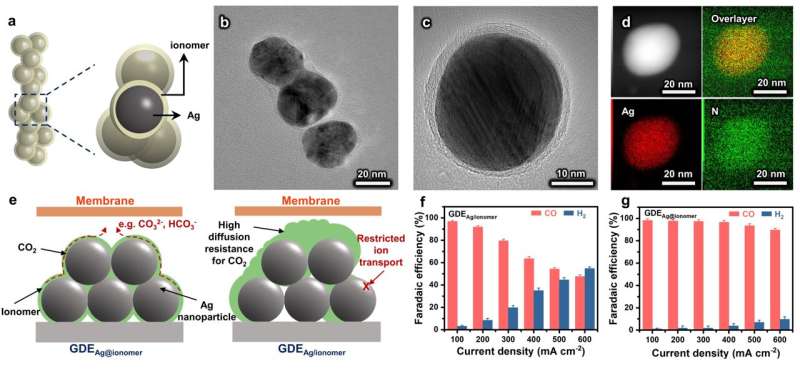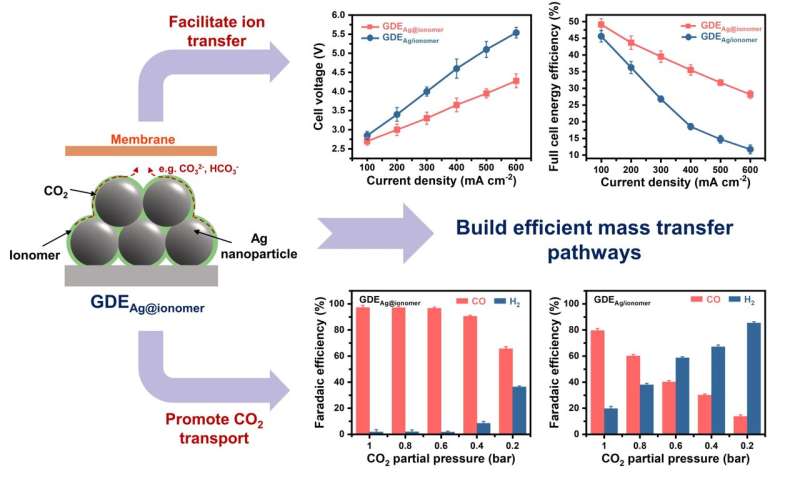
The ionomer is homogeneously distributed around each catalyst particle. The GDE using the ionomer-confined electrocatalyst optimizes the distribution of ionomer within catalyst layer, which not only builds paths for the promoted transport of ions but also facilitates the mass transfer of CO2. Credit: Science China Press
Since the amount of carbon dioxide (CO2) in the atmosphere is increasing because of human activities, the accelerated greenhouse effect and global warming have become common concerns. To mitigate such environmental problems, various technologies have been developed to utilize CO2.
Electrocatalytic CO2 reduction reaction (CO2RR) is an eminently attractive technology to convert CO2 into value-added products using renewable energy (e.g., solar and wind energy). To meet the requirements for industrial applications of CO2RR, gas diffusion electrodes (GDEs)-based membrane electrode assemblies (MEAs) are widely employed.
In the GDE, the catalyst layer (CL) is the main place for the catalytic reaction, which normally contains the catalyst, the catalyst carrier, and the ionomer. The preparation of CLs by ink-based methods usually suffers from inhomogeneous distribution of ionomer, which affects the transport of ions and CO2.
Therefore, rational optimization of the spatial distribution of ionomer is beneficial to promote mass transfer and enhance catalytic performance. In addition to methods such as adjusting the solvent polarity and improving the interaction between the catalyst and ionomer, there is still a demand to develop a more proactive and controllable approach to further optimize the distribution of ionomer to achieve good performance for the practical application of CO2RR systems.

A pre-confinement method was developed to construct a gas diffusion electrode for electrochemical CO2 reduction reaction with the uniformly distributed ionomer. The obtained electrode exhibits a low cell voltage of about 3.3 V at 300 mA cm−2 and a high CO Faradaic efficiency of over 90% at 600 mA cm−2 because of the enhanced mass transfer of ions and reactant. Credit: Science China Press
In response to this challenge, the Energy and Catalysis Adventure Team led by Professor Jinlong Gong from Tianjin University has developed an ionomer pre-confinement method. Specifically, ionomer was introduced during the synthetic process of electrocatalyst, leading to the formation of the ionomer-confined electrocatalyst for the construction of GDEs. This method favors the construction of GDEs with uniform distribution of ionomer, thereupon remitting the mass transfer problems caused by its accumulation.
By optimizing the distribution of ionomer in the GDEs, the ion transport within the CL is promoted. The ions generated at the reaction sites could be rapidly transferred to the anode. Furthermore, the spatially uniform ionomer avoids the high local mass transfer resistance caused by ionomer accumulation, which enhances CO2 transport and improves the catalytic performance.
Therefore, the optimized GDEs possessed a relatively low cell voltage (about 3.3 V at 300 mA cm−2) and a high CO Faradaic efficiency of over 90% even at a high current density of 600 mA cm−2. This electrode also achieves stable catalysis at a current density of 300 mA cm−2 for more than 220 h. It is envisioned that the information gathered in this study will inspire the optimal design of the GDEs, thus providing a reference for realizing the practical application of CO2RR.
More information:
Xiaowei Du et al, Confinement of ionomer for electrocatalytic CO2 reduction reaction via efficient mass transfer pathways, National Science Review (2023). DOI: 10.1093/nsr/nwad149
Citation:
Building efficient mass transfer pathways for electrocatalytic carbon dioxide reduction reaction (2023, July 24)
retrieved 24 July 2023
from https://phys.org/news/2023-07-efficient-mass-pathways-electrocatalytic-carbon.html
This document is subject to copyright. Apart from any fair dealing for the purpose of private study or research, no
part may be reproduced without the written permission. The content is provided for information purposes only.
>>> Read full article>>>
Copyright for syndicated content belongs to the linked Source : Phys.org – https://phys.org/news/2023-07-efficient-mass-pathways-electrocatalytic-carbon.html






























